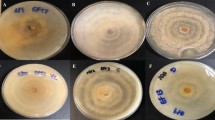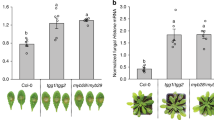Abstract
The fungal plant pathogen Sclerotinia sclerotiorum was studied to determine its ability to degrade salicylate, an important defense-signaling molecule in plants. S. sclerotiorum D-E7 was grown at 25 °C in an undefined medium (50 ml) containing minerals, 0.1 % soytone, 50 mM MES buffer (pH 6.5), 25 mM glucose, and 1 mM salicylate. Glucose, oxalate, and salicylate concentrations were monitored by HPLC. S. sclerotiorum D-E7 was found to be active in salicylate degradation. However, salicylate alone was not growth supportive and, at higher levels (10 mM), inhibited glucose-dependent growth. Biomass formation (130 mg [dry wt] of mycelium per 50 ml of undefined medium), oxalate concentrations (~10 mM), and culture acidification (final culture pH approximated 5) were essentially the same in cultures grown with or without salicylate (1 mM). Time-course analyses revealed that salicylate degradation and glucose consumption were complete after 7 days of incubation and was concomitant with growth. Trace amounts of catechol, a known intermediate of salicylate metabolism, were detected during salicylate degradation. Overall, these results indicated that S. sclerotiorum has the ability to degrade salicylate and that the presence of low levels of salicylate did not affect growth or oxalate production by S. sclerotiorum.


Similar content being viewed by others
References
Agrios GN (1997) Plant pathology, 4th edn. Academic Press, San Diego
Amborabé B-E, Fleurat-Lessard P, Chollet J-F, Roblin G (2002) Antifungal effects of salicylic acid and other benzoic acid derivatives towards Eutypa lata: structure–activity relationship. Plant Physiol Biochem 40:1051–1060
Amin AR, Vyas P, Modi VV (1984) Catabolism of benzoate and salicylate by Aspergillus japonicus. Indian J Exp Biol 22:220–221
Amselem J, Cuomo CA, van Kan JAL, Viaud M, Benito EP, Couloux A, Coutinho PM, de Vries RP, Dyer PS, Fillinger S, Fournier E, Gout L, Hahn M, Kohn L, Lapalu N, Plummer KM, Pradier J-M, Quévillon E, Sharon A, Simon A, ten Have A, Tudzynski B, Tudzynski P, Wincker P, Andrew M, Anthouard V, Beever RE, Beffa R, Benoit I, Bouzid O, Brault B, Chen Z, Choquer M, Collémare J, Cotton P, Danchin EG, Da Silva C, Gautier A, Giraud C, Giraud T, Gonzalez C, Grossetete S, Güldener U, Henrissat B, Howlett BJ, Kodira C, Kretschmer M, Lappartient A, Leroch M, Levis C, Mauceli E, Neuvéglise C, Oeser B, Pearson M, Poulain J, Poussereau N, Quesneville H, Rascle C, Schumacher J, Ségurens B, Sexton A, Silva E, Sirven C, Soanes DM, Talbot NJ, Templeton M, Yandava C, Yarden O, Zeng Q, Rollins JA, Lebrun M-H, Dickman M (2011) Genomic analysis of the necrotrophic fungal pathogens Sclerotinia sclerotiorum and Botrytis cinerea. PLoS Genet 7:e1002230. doi:10.1371/journal.pgen.1002230
Anderson JJ, Dagley S (1980) Catabolism of aromatic acids in Trichosporon cutaneum. J Bacteriol 141:534–543
Bachman DM, Dragoon B, John S (1960) Reduction of salicylate to saligenin by Neurospora. Arch Biochem Biophys 91:326
Bari R, Jones JDG (2009) Role of plant hormones in plant defence responses. Plant Mol Biol 69:473–488
Beckers GJM, Spoel SH (2005) Fine-tuning plant defence signalling: salicylate versus jasmonate. Plant Biol 8:1–10
Bergauer P, Fonteyne P-A, Nolard N, Schinner F, Margesin R (2005) Biodegradation of phenol and phenol-related compounds by psychrophilic and cold-tolerant alpine yeasts. Chemosphere 59:909–918
Boland GJ, Hall R (1994) Index of plant hosts of Sclerotinia sclerotiorum. Can J Plant Pathol 16:93–108
Bolton MD, Thomma BPHJ, Nelson BD (2006) Sclerotinia sclerotiorum (Lib.) de Bary: biology and molecular traits of a cosmopolitan pathogen. Mol Plant Pathol 7:1–16
Buswell JA, Paterson A, Salkinoja-Salonen MS (1980) Hydroxylation of salicylic acid to gentisate by a bacterial enzyme. FEMS Microbiol Lett 8:135–137
Cain RB, Bilton RF, Darrah JA (1968) The metabolism of aromatic acids by micro-organisms. Biochem J 108:797–828
Cowan MM (1999) Plant products as antimicrobial agents. Clin Microbiol Rev 12:564–582
Culbertson BJ, Furumo NC, Daniel SL (2007) Impact of nutritional supplements and monosaccharides on growth, oxalate accumulation, and culture pH by Sclerotinia sclerotiorum. FEMS Microbiol Lett 270:132–138
Culbertson BJ, Krone J, Gatebe E, Furumo NC, Daniel SL (2007) Impact of carbon sources on growth and oxalate synthesis by the phytopathogenic fungus Sclerotinia sclerotiorum. World J Microbiol Biotechnol 23:1357–1362
Dagley S (1971) Catabolism of aromatic compounds by microorganisms. Adv Microb Physiol 6:1–46
de Bary A (1886) Ueber einige Sclerotinen und Sclerotienkrankheiten. Bot Z 44:377–387, 393–404, 409–426
Deveryshetty J, Suvekbala V, Varadamshetty G, Phale P (2007) Metabolism of 2-, 3- and 4-hydroxybenzoates by soil isolates Alcaligenes sp. strain PPH and Pseudomonas sp. strain PPD. FEMS Microbiol Lett 268:59–66
Dodge AG, Wackett LP (2005) Metabolism of bismuth subsalicylate and intracellular accumulation of bismuth by Fusarium sp. strain BI. Appl Environ Microbiol 71:876–882
Engelhardt G, Rast HG, Wallnöfer PR (1979) Degradation of aromatic carboxylic acids by Nocardia spec. DSM 43251. FEMS Microbiol Lett 5:245–251
Glazebrook J (2005) Contrasting mechanisms of defense against biotrophic and necrotrophic pathogens. Annu Rev Phytopathol 43:205–227
Godoy G, Steadman JR, Dickman MB, Dam R (1990) Use of mutants to demonstrate the role of oxalic acid in pathogenicity of Sclerorinia sclerotiorum on Phaseolus vulgaris. Physiol Mol Plant Pathol 37:179–191
Grau CR, Hartman GL (1999) Sclerotinia stem rot. In: Hartman GL, Sinclair JB, Rupe JC (eds) Compendium of soybean diseases. APS Press, St. Paul, pp 46–48
Grund E, Knorr C, Eichenlaub R (1990) Catabolism of benzoate and monohydroxylated benzoates by Amycolatopsis and Streptomyces spp. Appl Environ Microbiol 56:1459–1464
Guo X, Stotz HU (2007) Defense against Sclerotinia sclerotiorum in Arabidopsis is dependent on jasmonic acid, salicylic acid, and ethylene signaling. Mol Plant-Microbe Interact 20:1384–1395
Halim VA, Vess A, Scheel D, Rosahl S (2006) The role of salicylic acid and jasmonic acid in pathogen defence. Plant Biol 8:307–313
Haribabu B, Kamath AV, Vaidyanathan CS (1984) Degradation of substituted benzoic acids by a Micrococcus species. FEMS Microbiol Lett 21:197–200
Hinter JP, Lechner C, Riegert U, Kuhm AE, Storm T, Reemtsma T, Stolz A (2001) Direct ring fission of salicylate by a salicylate 1,2-dioxygenase activity from Pseudaminobacter salicylatoxidans. J Bacteriol 183:6936–6942
Ishiyama D, Vujaklija D, Davies J (2004) Novel pathway of salicylate degradation by Streptomyces sp. strain WA46. Appl Environ Microbiol 70:1297–1306
Iwasaki Y, Gunji H, Kino K, Hattori T, Ishii Y, Kirimura K (2010) Novel metabolic pathway for salicylate biodegradation via phenol in yeast Trichosporon moniliiforme. Biodegradation 21:557–564
Jouanneau Y, Micoud J, Meyer C (2007) Purification and characterization of a three-component salicylate 1-hydroxylase from Sphingomonas sp. strain CHY-1. Appl Environ Microbiol 73:7515–7521
Karegoudar TB, Kim C-K (2000) Microbial degradation of monohydroxybenzoic acids. J Microbiol 38:53–61
Kocaçalışkana I, Talanb I, Terzic I (2006) Antimicrobial activity of catechol and pyrogallol as allelochemicals. Z Naturforsch 61c:639–642
Krupka LR, Racle FA (1967) Degradation of salicylate by Aspergillus niger. Nature 216:486–487
Krupka LR, Racle FA, Marderosian AD (1969) Salicylate degradation by Aspergillus niger: influence of glucose. J Pharm Sci 58:270–272
Kuswandi K, Roberts CF (1992) Genetic control of protocatechuic acid pathway in Aspergillus nidulans. J Gen Microbiol 138:817–823
Lanfranconi MP, Christie-Oleza JA, Martin-Cardona C, Suárez-Suárez LY, Lalucat J, Nogales B, Bosch R (2009) Physiological role of NahW, the additional salicylate hydroxylase found in Pseudomonas stutzeri AN10. FEMS Microbiol Lett 300:265–272
Magro P, Marciano P, Di Lenna P (1984) Oxalic acid production and its role in pathogenesis of Sclerotinia sclerotiorum (sunflower). FEMS Microbiol Lett 24:9–12
Marciano P, Lenna PD, Magro P (1983) Oxalic acid, cell wall-degrading enzymes and pH in pathogenesis and their significance in the virulence of two Sclerotinia sclerotiorum isolates on sunflower. Physiol Plant Pathol 22:339–345
Marciano P, Magro P, Favaron F (1989) Sclerotinia sclerotiorum growth and oxalic acid production on selected culture media. FEMS Microbiol Lett 61:57–69
Matera I, Ferraroni M, Burger S, Scozzafova A, Stolz A, Briganti F (2008) Salicylate 1,2-dioxygenase from Pseudaminobacter salicylatoxidans: crystal structure of a peculiar ring-cleaving dioxygenase. J Mol Biol 380:856–868
Maxwell DP, Lumsden RD (1970) Oxalic acid production by Sclerotinia sclerotiorum in infected bean and in culture. Phytopathology 60:1395–1398
Middelhoven WJ (1993) Catabolism of benzene compounds by ascomycetous and basidiomycetous yeasts and yeastlike fungi. Antonie Van Leeuwenhoek 63:125–144
Mills SC, Child JJ, Spencer JFT (1971) The utilization of aromatic compounds by yeasts. Antonie Van Leeuwenhoek 37:281–287
Mouttaki H, Nanny MA, McInerney MJ (2009) Metabolism of hydroxylated and fluorinated benzoates by Syntrophus aciditrophicus and detection of a fluorodiene metabolite. Appl Environ Microbiol 75:998–1004
Noyes RD, Hancock JG (1981) Role of oxalic acid in the Sclerotinia wilt of sunflower. Physiol Plant Pathol 18:123–132
Park S-W, Kaimoyo E, Kumar D, Mosher S, Klessig D (2007) Methyl salicylate is a crucial mobile signal for plant systemic acquired resistance. Science 318:113–116
Peng R-H, Xiong A-S, Xue Y, Fu X-Y, Gao F, Zhao W, Tian Y-S, Yao Q-H (2008) Microbial degradation of polyaromatic hydrocarbons. FEMS Microbiol Rev 32:927–955
Purdy LH (1979) Sclerotinia sclerotiorum: history, diseases and symptomatology, host range, geographic distribution, and impact. Phytopathology 69:875–880
Qi P-F, Johnston A, Balcerzak M, Rocheleau H, Harris L, Long X-Y, Wei Y-M, Zheng Y-L, Ouellet T (2012) Effect of salicylic acid on Fusarium graminearum, the major causal agent of fusarium head blight in wheat. Fungal Biol 116:413–426
Rollins JA, Dickman MB (2001) pH signaling in Sclerotinia sclerotiorum: identification of a pacC/RIM1 homolog. Appl Environ Microbiol 67:75–81
Sazonova OI, Izmalkova TY, Kosheleva IA, Boronin AM (2008) Salicylate degradation by Pseudomonas putida strains not involving the “classical” nah2 operon. Microbiology 77:710–716
Sclerotinia sclerotiorum Sequencing Project (2012) Broad Institute of Harvard and MIT. www.broadinstitute.org/annotation/genome/sclerotinia_sclerotiorum/MultiHome.html
Shailubhai K, Somayaji R, Rao NN, Modi VV (1983) Metabolism of resorcinol and salicylate in Aspergillus niger. Experientia 39:70–72
Smith JL, Moraes CMD, Mescher MC (2009) Jasmonate- and salicylate-mediated plant defense responses to insect herbivores, pathogens and parasitic plants. Pest Manage Sci 65:497–503
Steadman JR (1983) White mold-a serious yield limiting disease of bean. Plant Dis 67:346–350
Suemori A, Nakajima K, Kurane R, Nakamura Y (1995) o-, m-, and p-Hydroxybenzoate degradative pathways in Rhodococcus erythropolis. FEMS Microbiol Lett 125:31–36
Thaler JS, Humphrey PT, Whiteman NK (2012) Evolution of jasmonate and salicylate signal crosstalk. Trends Plant Sci 17:260–270
Tu JC (1985) Tolerance of white bean (Phaseolus vulgaris) to white mold (Sclerotinia sclerotiorum) associated with tolerance to oxalic acid. Physiol Plant Pathol 26:111–117
Vega RR, Corsini D, Le Tourneau D (1970) Nonvolatile organic acids produced by Sclerotinia sclerotiorum in synthetic liquid media. Mycologia 62:332–338
Wang Z, Tan X, Zhang Z, Gu S, Li G, Shi H (2012) Defense to Sclerotinia sclerotiorum in oilseed rape is associated with the sequential activations of salicylic acid signaling and jasmonic acid signaling. Plant Sci 184:75–82
Willetts HJ, Wong JA-L (1980) The biology of Sclerotinia sclerotiorum, S. trifoliorum, and S. minor with emphasis on specific nomenclature. Bot Rev 46:100–165
Zhao S, Qi X (2008) Signaling in plant disease resistance and symbiosis. J Integr Plant Biol 50:799–807
Ziman L, Jedryczka M, Srobarova A (1998) Relationship between morphological and biochemical characteristics of Sclerotinia sclerotiorum isolates and their aggressivity. Z Pflanzenkr Pflanzenschutz 105:283–288
Acknowledgments
We express appreciation to the National Soybean Pathogen Collection Center at the University of Illinois at Urbana-Champaign for providing us with cultures of S. sclerotiorum. Funding for this project was provided by two Biological Sciences undergraduate research grants (CDP), a College of Sciences seed grant (SLD), and a Proposal Initiative Fund grant (SLD), all from Eastern Illinois University.
Conflict of interest
The authors declare no conflict of interest.
Author information
Authors and Affiliations
Corresponding author
Rights and permissions
About this article
Cite this article
Penn, C.D., Daniel, S.L. Salicylate Degradation by the Fungal Plant Pathogen Sclerotinia sclerotiorum . Curr Microbiol 67, 218–225 (2013). https://doi.org/10.1007/s00284-013-0349-y
Received:
Accepted:
Published:
Issue Date:
DOI: https://doi.org/10.1007/s00284-013-0349-y




